Synergies and Trade-Offs between Lean-Green Practices from the Perspective of Operations Strategy: A Systematic Literature Review
Abstract
:1. Introduction
2. Theoretical Background
3. Research Design
3.1. Research Question Formulation
- RQ1. Does the implementation of Lean and Green practices affect operations’ competitive priorities, causing synergies or trade-offs?
- RQ2. What decision area(s) are modified with the implementation of each practice?
3.2. Search Strategy
3.3. Selection and Evaluation of Relevant Studies
3.4. Analysis and Synthesis of the Results
4. Results and Discussion
4.1. Descriptive Analysis
4.2. Discussion
4.2.1. Lean Practices
4.2.2. Green Practices
4.2.3. Lean-Green Practices
E-VSM (Environmental Value Stream Map)
7s
Root Cause Analysis for Environmental Problems
OEEE
Lean and Green Supply Chain
Kaizen with Green Goals
Lean with Environmental Indicators
Lean 3R
Green Lean Six Sigma
Total Quality Environmental Management—TQEM
Green MRP
Closing Remarks from Lean-Green Practices
4.3. Summary and Research Agenda
- Verifying the existence of unidentified trade-offs between the Lean and Green, as well as understanding how, and how much, the competitive priorities are affected; and evaluating quantitatively the relationship between individual practices and the contribution for the competitive priorities.
- Exploring in-depth the changes and the contribution from LG implementation in the decision areas; and exploring the particularities of each practice to be implemented.
- Empirical studies examining how companies frame their competitive priorities and decision areas in different levels of Lean and Green implementation and in different industrial sectors. Further, the researchers in operations management may quantify the performance of the companies related with the operation strategy adopted.
- Quantifying the synergy between the LG empirically, exploring different industrial sectors as well as different operations strategies.
- Identifying and comparing the reasons for OS formulation and Lean-GP adoption, and discussing their strategic role.
- Understanding how the Circular Economy strategies can be supported by Lean and Green Manufacturing practices.
- In terms of research methods, based on theoretical propositions identified qualitatively by most of the researched literature, quantitative approaches can be developed, such as surveys and modeling, to confirm them.
5. Conclusions
Author Contributions
Funding
Institutional Review Board Statement
Informed Consent Statement
Data Availability Statement
Conflicts of Interest
References
- Acerbi, F.; Sassanelli, C.; Terzi, S.; Taisch, M. A Systematic Literature Review on Data and Information Required for Circular Manufacturing Strategies Adoption. Sustainability 2021, 13, 2047. [Google Scholar] [CrossRef]
- Erdil, N.O.; Aktas, C.B.; Arani, O.M. Embedding Sustainability in Lean Six Sigma Efforts. J. Clean. Prod. 2018, 198, 520–529. [Google Scholar] [CrossRef]
- Vinodh, S.; Ramesh, K.; Arun, C.S. Application of Interpretive Structural Modelling for Analysing the Factors Influencing Integrated Lean Sustainable System. Clean Technol Environ. Policy 2016, 18, 413–428. [Google Scholar] [CrossRef]
- Garza-Reyes, J.A. Lean and Green-a Systematic Review of the State of the Art Literature. J. Clean. Prod. 2015, 102, 18–29. [Google Scholar] [CrossRef] [Green Version]
- Longoni, A.; Cagliano, R. Environmental and Social Sustainability Prioritiesn: Their Integration in Operations Strategies. Int. J. Oper. Prod. Manag. 2015, 35, 216–345. [Google Scholar] [CrossRef]
- Leong, W.D.; Teng, S.Y.; How, B.S.; Ngan, S.L.; Rahman, A.A.; Tan, C.P.; Ponnambalam, S.G.; Lam, H.L. Enhancing the Adaptability: Lean and Green Strategy towards the Industry Revolution 4.0. J. Clean. Prod. 2020, 273, 122870. [Google Scholar] [CrossRef]
- Viles, E.; Santos, J.; Muñoz-Villamizar, A.; Grau, P.; Fernández-Arévalo, T. Lean–Green Improvement Opportunities for Sustainable Manufacturing Using Water Telemetry in Agri-Food Industry. Sustainability 2021, 13, 2240. [Google Scholar] [CrossRef]
- Goyal, A.; Vaish, D.C.; Agrawal, R.; Choudhary, S.; Nayak, R. Sustainable Manufacturing through Systematic Reduction in Cycle Time. Sustainability 2022, 14, 6473. [Google Scholar] [CrossRef]
- Caldera, H.T.S.; Desha, C.; Dawes, L. Evaluating the Enablers and Barriers for Successful Implementation of Sustainable Business Practice in ‘Lean’ SMEs. J. Clean. Prod. 2019, 218, 575–590. [Google Scholar] [CrossRef]
- Garza-Reyes, J.A.; Kumar, V.; Chaikittisilp, S.; Tan, K.H. The Effect of Lean Methods and Tools on the Environmental Performance of Manufacturing Organisations. Int. J. Prod. Econ. 2018, 200, 170–180. [Google Scholar] [CrossRef]
- Vinodh, S.; Arvind, K.R.; Somanaathan, M. Tools and Techniques for Enabling Sustainability through Lean Initiatives. Clean Technol. Environ. Policy 2011, 13, 469–479. [Google Scholar] [CrossRef]
- Florida, R. Lean and Green: The Move to Environmentally Conscious Manufacturing. Calif. Manag. Rev. 1996, 39, 80–105. [Google Scholar] [CrossRef]
- Ghobakhloo, M.; Azar, A.; Fathi, M. Lean-Green Manufacturing: The Enabling Role of Information Technology Resource. Kybernetes 2018, 47, 1752–1777. [Google Scholar] [CrossRef]
- Ng, R.; Low, J.S.C.; Song, B. Integrating and Implementing Lean and Green Practices Based on Proposition of Carbon-Value Efficiency Metric. J. Clean. Prod. 2015, 95, 242–255. [Google Scholar] [CrossRef]
- Salvador, R.; Piekarski, C.M.; Francisco, A.C. de Approach of the Two-Way Influence Between Lean and Green Manufacturing and Its Connection to Related Organisational Areas. Int. J. Prod. Manag. Eng. 2017, 5, 73. [Google Scholar] [CrossRef] [Green Version]
- Zhu, X.; Zhang, H.; Wu, C.; Huang, Z. An Economic Model of Integration Framework of Lean Production and Green Manufacturing Based on Sustainability Balanced Scorecard. Bol. Tec. Tech. Bull. 2017, 55, 263–269. [Google Scholar]
- Mollenkopf, D.; Stolze, H.; Tate, W.L.; Ueltschy, M. Green, Lean, and Global Supply Chains. Int. J. Phys. Distrib. Logist. Manag. 2010, 40, 14–41. [Google Scholar] [CrossRef]
- Thanki, S.; Govindan, K.; Thakkar, J. An Investigation on Lean-Green Implementation Practices in Indian SMEs Using Analytical Hierarchy Process (AHP) Approach. J. Clean. Prod. 2016, 135, 284–298. [Google Scholar] [CrossRef]
- Duarte, S.; Cruz Machado, V. Green and Lean Implementation: An Assessment in the Automotive Industry. Int. J. Lean Six Sigma 2017, 8, 65–88. [Google Scholar] [CrossRef]
- Rothenberg, S.; Pil, F.K.; Maxwell, J. Lean, Green, and the Quest for Superior Environmental Performance. Prod. Oper. Manag. 2001, 10, 228–243. [Google Scholar] [CrossRef]
- Marudhamuthu, R. The Development of Green Environment Through. J. Eng. Appl. Sci. 2011, 6, 104–111. [Google Scholar]
- Hajmohammad, S.; Vachon, S.; Klassen, R.D.; Gavronski, I. Lean Management and Supply Management: Their Role in Green Practices and Performance. J. Clean. Prod. 2013, 39, 312–320. [Google Scholar] [CrossRef]
- Jabbour, C.J.C.; De Sousa Jabbour, A.B.L.; Govindan, K.; Teixeira, A.A.; De Souza Freitas, W.R. Environmental Management and Operational Performance in Automotive Companies in Brazil: The Role of Human Resource Management and Lean Manufacturing. J. Clean. Prod. 2013, 47, 129–140. [Google Scholar] [CrossRef]
- Resta, B.; Dotti, S.; Gaiardelli, P.; Boffelli, A. How Lean Manufacturing Affects the Creation of Sustainable Value: An Integrated Model. Int. J. Autom. Technol. 2017, 11, 542–551. [Google Scholar] [CrossRef]
- Souza, J.P.E.; Alves, J.M. Lean-Integrated Management System: A Model for Sustainability Improvement. J. Clean. Prod. 2018, 172, 2667–2682. [Google Scholar] [CrossRef]
- Queiroz, G.A.; Filho, A.G.A.; Costa Melo, I. Competitive Priorities and Lean–Green Practices—A Comparative Study in the Automotive Chain’ Suppliers. Machines 2023, 11, 50. [Google Scholar] [CrossRef]
- Díaz-Reza, J.R.; García-Alcaraz, J.L.; Figueroa, L.J.M.; Vidal, R.P.I.; Muro, J.C.S.D. Relationship between Lean Manufacturing Tools and Their Sustainable Economic Benefits. Int. J. Adv. Manuf. Technol. 2022, 123, 1269–1284. [Google Scholar] [CrossRef]
- Afum, E.; Sun, Z.; Agyabeng-Mensah, Y.; Baah, C. Lean Production Systems, Social Sustainability Performance and Green Competitiveness: The Mediating Roles of Green Technology Adoption and Green Product Innovation. J. Eng. Des. Technol. 2023, 21, 206–227. [Google Scholar] [CrossRef]
- Muñoz-Villamizar, A.; Santos, J.; Grau, P.; Viles, E. Toolkit for Simultaneously Improving Production and Environmental Efficiencies. Central Eur. J. Oper. Res. 2021, 29, 1219–1230. [Google Scholar] [CrossRef]
- Alves, J.R.X.; Alves, J.M. Production Management Model Integrating the Principles of Lean Manufacturing and Sustainability Supported by the Cultural Transformation of a Company. Int. J. Prod. Res. 2015, 53, 5320–5333. [Google Scholar] [CrossRef]
- Domingo, R.; Aguado, S. Overall Environmental Equipment Effectiveness as a Metric of a Lean and Green Manufacturing System. Sustainability 2015, 7, 9031–9047. [Google Scholar] [CrossRef] [Green Version]
- Vinodh, S.; Ben Ruben, R.; Asokan, P. Life Cycle Assessment Integrated Value Stream Mapping Framework to Ensure Sustainable Manufacturing: A Case Study. Clean Technol. Environ. Policy 2016, 18, 279–295. [Google Scholar] [CrossRef]
- Cherrafi, A.; Elfezazi, S.; Chiarini, A.; Mokhlis, A.; Benhida, K. The Integration of Lean Manufacturing, Six Sigma and Sustainability: A Literature Review and Future Research Directions for Developing a Specific Model. J. Clean. Prod. 2016, 139, 828–846. [Google Scholar] [CrossRef]
- Prasad, S.; Khanduja, D.; Sharma, S.K. An Empirical Study on Applicability of Lean and Green Practices in the Foundry Industry. J. Manuf. Technol. Manag. 2016, 27, 408–426. [Google Scholar] [CrossRef]
- Raghu Kumar, B.R.; Agarwal, A.; Sharma, M.K. Lean Management—A Step towards Sustainable Green Supply Chain. Compet. Rev. 2016, 26, 311–331. [Google Scholar] [CrossRef]
- Farias, L.M.S.; Santos, L.C.; Gohr, C.F.; de Oliveira, L.C.; Amorim, M.H. da S. Criteria and Practices for Lean and Green Performance Assessment: Systematic Review and Conceptual Framework. J. Clean. Prod. 2019, 218, 746–762. [Google Scholar] [CrossRef]
- Ben Ruben, R.; Vinodh, S.; Asokan, P. Implementation of Lean Six Sigma Framework with Environmental Considerations in an Indian Automotive Component Manufacturing Firm: A Case Study. Prod. Plan. Control 2017, 28, 1193–1211. [Google Scholar] [CrossRef]
- Kaswan, M.S.; Rathi, R. Green Lean Six Sigma for Sustainable Development: Integration and Framework. Env. Impact Assess. Rev. 2020, 83, 106396. [Google Scholar] [CrossRef]
- Singh, R.K.; Kumar Mangla, S.; Bhatia, M.S.; Luthra, S. Integration of Green and Lean Practices for Sustainable Business Management. Bus Strat. Environ. 2022, 31, 353–370. [Google Scholar] [CrossRef]
- Gandhi, J.; Thanki, S.; Thakkar, J.J. An Investigation and Implementation Framework of Lean Green and Six Sigma (LG&SS) Strategies for the Manufacturing Industry in India. TQM J. 2021, 33, 1705–1734. [Google Scholar] [CrossRef]
- Chiarini, A. Sustainable Manufacturing-Greening Processes Using Specific Lean Production Tools: An Empirical Observation from European Motorcycle Component Manufacturers. J. Clean. Prod. 2014, 85, 226–233. [Google Scholar] [CrossRef]
- Salah, S.A.; Mustafa, A. Integration of Energy Saving with Lean Production in a Food Processing Company. J. Mach. Eng. 2021, 21, 118–133. [Google Scholar] [CrossRef]
- Kazancoglu, Y.; Ekinci, E.; Ozen, Y.D.O.; Pala, M.O. Forum Reducing Food Waste Through Lean and Sustainable Operations: A Case Study From The Poultry Industry. RAE 2020, 61, 1–18. [Google Scholar]
- Ferrone, B. Environmental Business Management Practices for a New Age. Change Manag. 1996, 5, 1–7. [Google Scholar] [CrossRef]
- Galeazzo, A.; Furlan, A.; Vinelli, A. Lean and Green in Action: Interdependencies and Performance of Pollution Prevention Projects. J. Clean. Prod. 2014, 85, 191–200. [Google Scholar] [CrossRef]
- Ball, P. Low Energy Production Impact on Lean Flow. J. Manuf. Technol. Manag. 2015, 26, 412–428. [Google Scholar] [CrossRef]
- Campos, L.M.S.; Vazquez-Brust, D.A. Lean and Green Synergies in Supply Chain Management. Supply Chain Manag. 2016, 21, 627–641. [Google Scholar] [CrossRef]
- Mor, R.S.; Singh, S.; Bhardwaj, A. Learning on Lean Production: A Review of Opinion and Research within Environmental Constraints. Oper. Supply Chain Manag. 2016, 9, 61–72. [Google Scholar] [CrossRef] [Green Version]
- Sartal, A.; Martinez-Senra, A.I.; Cruz-Machado, V. Are All Lean Principles Equally Eco-Friendly? A Panel Data Study. J. Clean. Prod. 2018, 177, 362–370. [Google Scholar] [CrossRef]
- Azevedo, S.G.; Carvalho, H.; Cruz-Machado, V. LARG Index: A Benchmarking Tool for Improving the Leanness, Agility, Resilience and Greenness of the Automotive Supply Chain. Benchmarking 2016, 23, 1472–1499. [Google Scholar] [CrossRef]
- Chatha, K.A.; Butt, I. Themes of Study in Manufacturing Strategy Literature. Int. J. Oper. Prod. Manag. 2015, 35, 604–698. [Google Scholar] [CrossRef]
- Longoni, A.; Cagliano, R. Cross-Functional Executive Involvement and Worker Involvement in Lean Manufacturing and Sustainability Alignment. Int. J. Oper. Prod. Manag. 2015, 35, 1332–1358. [Google Scholar] [CrossRef]
- Suifan, T.; Alazab, M.; Alhyari, S. Trade-off among Lean, Agile, Resilient and Green Paradigms: An Empirical Study on Pharmaceutical Industry in Jordan Using a TOPSIS-Entropy Method. Int. J. Adv. Oper. Manag. 2019, 11, 69–101. [Google Scholar] [CrossRef]
- Sassanelli, C.; Rossi, M.; Pezzotta, G.; Augusto, D.; Pacheco, J.; Terzi, S. Defining Lean Product Service Systems Features and Research Trends through a Systematic Literature Review; Inderscience Publishers: Geneva, Switzerland, 2019; Volume 12. [Google Scholar]
- de Carvalho, A.C.V.; Granja, A.D.; da Silva, V.G. A Systematic Literature Review on Integrative Lean and Sustainability Synergies over a Building’s Lifecycle. Sustainability 2017, 9, 1156. [Google Scholar] [CrossRef] [Green Version]
- Caldera, H.T.S.; Desha, C.; Dawes, L. Exploring the Role of Lean Thinking in Sustainable Business Practice: A Systematic Literature Review. J. Clean. Prod. 2017, 167, 1546–1565. [Google Scholar] [CrossRef] [Green Version]
- Gaikwad, L.; Sunnapwar, V. An Integrated Lean, Green and Six Sigma Strategies: A Systematic Literature Review and Directions for Future Research. TQM J. 2020, 32, 201–225. [Google Scholar] [CrossRef]
- Saarani, P.S.N.; Abdul Tharim, A.H.; Che Ahmad, A.; Mohamed Salleh, R. A Systematic Literature Review (SLR) on the Strategies of Managing Waste in Relative to Green Building (GB) Practice. Pertanika J. Sci. Technol. 2022, 30, 1363–1380. [Google Scholar] [CrossRef]
- Sharma, V.; Raut, R.D.; Mangla, S.K.; Narkhede, B.E.; Luthra, S.; Gokhale, R. A Systematic Literature Review to Integrate Lean, Agile, Resilient, Green and Sustainable Paradigms in the Supply Chain Management. Bus Strategy Environ. 2021, 30, 1191–1212. [Google Scholar] [CrossRef]
- Queiroz, G.A. Estratégia de Operações e Práticas Lean-Green: Um Estudo de Casos Múltiplos Em Empresas Do Setor Automotivo. Ph.D Thesis, Federal University of São Carlos, São Carlos, Brazil, 2021. [Google Scholar]
- Slack, N.; Lewis, M. Operations Strategy, 3rd ed.; Pearson Education Limited: London, UK, 2011; ISBN 9780273740445. [Google Scholar]
- Skinner, W. Manufacturing—Missing Link in the Corporate Strategy. Harv. Bus Rev. 1969, 47, 136–145. [Google Scholar]
- Hilmola, O.P.; Lorentz, H.; Hilletofth, P.; Malmsten, J. Manufacturing Strategy in SMEs and Its Performance Implications. Ind. Manag. Data Syst. 2015, 115, 1004–1021. [Google Scholar] [CrossRef]
- Voss, C.A. Paradigms of Manufacturing Strategy Re-Visited. Int. J. Oper. Prod. Manag. 2005, 25, 1223–1227. [Google Scholar] [CrossRef]
- Garvin, D.A. Manufacturing Strategic Planning. Calif.Manag. Rev. 1993, 35, 85–106. [Google Scholar] [CrossRef]
- Wheelwright, S.C. Manufacturing Strategy: Defining the Missing Link. Strateg. Manag. J. 1984, 5, 77–91. [Google Scholar] [CrossRef]
- Voss, C.A. Alternative Paradigms for Manufacturing Strategy. Int. J. Oper. Prod. Manag. 1995, 15, 5–16. [Google Scholar] [CrossRef]
- Losonci, D.; Demeter, K. Lean Production and Business Performance: International Empirical Results. Compet. Rev. 2013, 23, 218–233. [Google Scholar] [CrossRef]
- Mostafa, S.; Dumrak, J.; Soltan, H. A Framework for Lean Manufacturing Implementation. Prod. Manuf. Res. 2013, 1, 44–64. [Google Scholar] [CrossRef] [Green Version]
- Bhasin, S.; Burcher, P. Lean Viewed as a Philosophy. J. Manuf. Technol. Manag. 2006, 17, 56–72. [Google Scholar] [CrossRef]
- Shah, R.; Ward, P.T. Defining and Developing Measures of Lean Production. J. Oper. Manag. 2007, 25, 785–805. [Google Scholar] [CrossRef]
- Shah, R.; Ward, P.T. Lean Manufacturing: Context, Practice Bundles, and Performance. J. Oper. Manag. 2003, 21, 129–149. [Google Scholar] [CrossRef] [Green Version]
- Kleindorfer, P.R.; Singhal, K.; Van Wassenhove, L.N. Sustainable Operations Management. Prod. Oper. Manag. 2005, 14, 482–492. [Google Scholar] [CrossRef]
- Pathak, P.; Singh, M.P. Sustainable Manufacturing Concepts: A Literature Review. Int. J. Eng. Technol. Manag. Res. 2017, 4, 1–13. [Google Scholar] [CrossRef]
- Silva, D.A.L.; da Silva, E.J.; Ometto, A.R. Green Manufacturing: Uma Análise Da Produção Científica e de Tendências Para o Futuro. Production 2015, 26, 642–655. [Google Scholar] [CrossRef] [Green Version]
- Pampanelli, A.B.; Found, P.; Bernardes, A.M. A Lean & Green Model for a Production Cell. J. Clean. Prod. 2014, 85, 19–30. [Google Scholar] [CrossRef]
- Bhattacharya, A.; Nand, A.; Castka, P. Lean-Green Integration and Its Impact on Sustainability Performance: A Critical Review. J. Clean. Prod. 2019, 236, 117697. [Google Scholar] [CrossRef]
- Aguado, S.; Alvarez, R.; Domingo, R. Model of Efficient and Sustainable Improvements in a Lean Production System through Processes of Environmental Innovation. J. Clean. Prod. 2013, 47, 141–148. [Google Scholar] [CrossRef]
- Anvari, A.; Zulkifli, N.; Yusuff, R.M. Evaluation of Approaches to Safety in Lean Manufacturing and Safety Management Systems and Clarification of the Relationship between Them. World Appl. Sci. J. 2011, 15, 19–26. [Google Scholar]
- Denyer, D.; Tranfield, D. Producing a Systematic Review. In The SAGE Handbook of Organizational Research Methods; Buchanan, D.A., Bryman, A., Eds.; Sage Publications Ltd.: Thousand Oaks, CA, USA, 2009; pp. 671–689. [Google Scholar]
- Moher, D.; Liberati, A.; Tetzlaff, J.; Altman, D.G. Preferred Reporting Items for Systematic Reviews and Meta-Analyses: The PRISMA Statement. PLoS Med. 2009, 6, e1000097. [Google Scholar] [CrossRef] [Green Version]
- Aghaei Chadegani, A.; Salehi, H.; Md Yunus, M.M.; Farhadi, H.; Fooladi, M.; Farhadi, M.; Ale Ebrahim, N. A Comparison between Two Main Academic Literature Collections: Web of Science and Scopus Databases. Asian Soc. Sci. 2013, 9, 18–26. [Google Scholar] [CrossRef] [Green Version]
- Slack, N. Operations Strategy; Bookboon: London, UK, 2015; ISBN 9788776818289. [Google Scholar]
- ben Ruben, R.; Vinodh, S.; Asokan, P. Lean Six Sigma with Environmental Focus: Review and Framework. Int. J. Adv. Manuf. Technol. 2018, 94, 4023–4037. [Google Scholar] [CrossRef]
- Šišková, V.; Dlabač, J. Environmental Management System as the Part of the Methodology for Optimization of Assembly Workplaces. Int. J. Math. Model. Methods Appl. Sci. 2013, 7, 428–435. [Google Scholar]
- Pham, D.T.; Thomas, A.J. Fit Manufacturing: A Framework for Sustainability. J. Manuf. Technol. Manag. 2011, 23, 103–123. [Google Scholar] [CrossRef]
- Hanson, J.; Melnyk, S.A.; Calantone, R. Core Values and Nation-States. Oppor. Chall. Biling. 2011, 87, 69–85. [Google Scholar] [CrossRef]
- Krippendorff, K. Content Analysis: An Introduction to Its Methodology, 2nd ed.; Sage Publications: Thousand Oaks, CA, USA, 2004; Volume 13. [Google Scholar]
- Hutchisona, A.J.; Johnstonb, L.H.; Breckona, J.D. Using QSR-NVivo to Facilitate the Development of a Grounded Theory Project: An Account of a Worked Example. Int. J. Soc. Res. Methodol. 2010, 13, 283–302. [Google Scholar] [CrossRef]
- Gibbs, G. Análise de Dados Qualitativos; Artmed, Ed.; Porto Alegre: Artmed, Brazil, 2009; 98p. [Google Scholar]
- UNCTAD—United Nations Conference on Trade and Development. Country Classification. Available online: https://unctadstat.unctad.org/en/classifications.html (accessed on 10 January 2023).
- Thanki, S.J.; Thakkar, J.J. Value–Value Load Diagram: A Graphical Tool for Lean–Green Performance Assessment. Prod. Plan. Control. 2016, 27, 1280–1297. [Google Scholar] [CrossRef]
- Gupta, S.; Dangayach, G.S.; Singh, A.K.; Meena, M.L.; Rao, P.N. Implementation of Sustainable Manufacturing Practices in Indian Manufacturing Companies. Benchmarking 2018, 25, 2441–2459. [Google Scholar] [CrossRef]
- Choudhary, S.; Nayak, R.; Dora, M.; Mishra, N.; Ghadge, A. An Integrated Lean and Green Approach for Improving Sustainability Performance: A Case Study of a Packaging Manufacturing SME in the UK. Prod. Plan. Control. 2019, 30, 353–368. [Google Scholar] [CrossRef]
- Belhadi, A.; Touriki, F.E.; El Fezazi, S. Benefits of Adopting Lean Production on Green Performance of SMEs: A Case Study. Prod. Plan. Control. 2018, 29, 873–894. [Google Scholar] [CrossRef]
- Dües, C.M.; Tan, K.H.; Lim, M. Green as the New Lean: How to Use Lean Practices as a Catalyst to Greening Your Supply Chain. J. Clean. Prod. 2013, 40, 93–100. [Google Scholar] [CrossRef] [Green Version]
- Ruiz-Benitez, R.; López, C.; Real, J.C. Environmental Benefits of Lean, Green and Resilient Supply Chain Management: The Case of the Aerospace Sector. J. Clean. Prod. 2017, 167, 850–862. [Google Scholar] [CrossRef]
- Siegel, R.; Antony, J.; Garza-Reyes, J.A.; Cherrafi, A.; Lameijer, B. Integrated Green Lean Approach and Sustainability for SMEs: From Literature Review to a Conceptual Framework. J. Clean. Prod. 2019, 240, 118205. [Google Scholar] [CrossRef]
- Azfar, K.R.W. Application of Lean Agile Resilient Green Paradigm Framework on China Pakistan Economic Corridor: A Case Study. Mehran Univ. Res. J. Eng. Technol. 2017, 36, 621–634. [Google Scholar] [CrossRef] [Green Version]
- Puvanasvaran, A.L.; Perumal, A.; Tian, R.K.S.; Vasu, S.A.L.; Muhamad, M.R. Integration Model of ISO 14001 with Lean Principles. Am. J. Appl. Sci. 2012, 9, 1974–1978. [Google Scholar] [CrossRef] [Green Version]
- Diaz-Elsayed, N.; Jondral, A.; Greinacher, S.; Dornfeld, D.; Lanza, G. Assessment of Lean and Green Strategies by Simulation of Manufacturing Systems in Discrete Production Environments. CIRP Ann. Manuf. Technol. 2013, 62, 475–478. [Google Scholar] [CrossRef] [Green Version]
- Vais, A.; Miron, V.; Pedersen, M.; Folke, J. “Lean and Green” at a Romanian Secondary Tissue Paper and Board Mill—Putting Theory into Practice. Resour. Conserv. Recycl. 2006, 46, 44–74. [Google Scholar] [CrossRef]
- King, A.A.; Lenox, M.J. Lean and Green? An Empirical Examination of the Relationship between Lean Production and Environmental Performance. Prod. Oper. Manag. 2001, 10, 244–256. [Google Scholar] [CrossRef]
- Crosby, B.; Badurdeen, F. Integrating Lean and Sustainable Manufacturing Principles for Sustainable Total Productive Maintenance (Sus-TPM). Smart Sustain. Manuf. Syst. 2022, 6, 20210025. [Google Scholar] [CrossRef]
- Teixeira, P.; Sá, J.C.; Silva, F.J.G.; Ferreira, L.P.; Santos, G.; Fontoura, P. Connecting Lean and Green with Sustainability towards a Conceptual Model. J. Clean. Prod. 2021, 322, 129047. [Google Scholar] [CrossRef]
- Abualfaraa, W.; AlManei, M.; Kaur, R.; Al-Ashaab, A.; McLaughlin, P.; Salonitis, K. A Synergetic Framework for Green and Lean Manufacturing Practices in SMEs: Saudi Arabia Perspective. Sustainability 2023, 15, 596. [Google Scholar] [CrossRef]
- Pil, F.K.; Rothenberg, S. Environmental Performance as a Driver of Superior Quality. Prod. Oper. Manag. 2003, 12, 404–415. [Google Scholar] [CrossRef]
- Fu, X.; Guo, M.; Zhanwen, N. Applying the Green Embedded Lean Production Model in Developing Countries: A Case Study of China. Environ. Dev. 2017, 24, 22–35. [Google Scholar] [CrossRef]
- Ben Ruben, R.; Asokan, P.; Vinodh, S. Performance Evaluation of Lean Sustainable Systems Using Adaptive Neuro Fuzzy Inference System: A Case Study. Int. J. Sustain. Eng. 2017, 10, 158–175. [Google Scholar] [CrossRef]
- Ho, S.; Hashim, A.G.B.M.; Idris, M.A.M. Applicability of SIRIM Green 5-S Model for Productivity & Business Growth in Malaysia. TQM J. 2015, 27, 185–196. [Google Scholar] [CrossRef]
- Miller, G.; Pawloski, J.; Standridge, C. A Case Study of Lean, Sustainable Manufacturing. J. Ind. Eng. Manag. 2010, 3, 11–32. [Google Scholar] [CrossRef] [Green Version]
- Torielli, R.M.; Abrahams, R.A.; Smillie, R.W.; Voigt, R.C. Using Lean Methodologies for Economically and Environmentally Sustainable Foundries. China Foundry 2010, 2, 710–726. [Google Scholar]
- Parmar, P.S.; Desai, T.N. Ranking the Solutions of Sustainable Lean Six Sigma Implementation in Indian Manufacturing Organization to Overcome Its Barriers. Int. J. Sustain. Eng. 2020, 14, 304–317. [Google Scholar] [CrossRef]
- Wiengarten, F.; Fynes, B.; Onofrei, G. Exploring Synergetic Effects between Investments in Environmental and Quality/Lean Practices in Supply Chains. Supply Chain Manag. 2013, 18, 148–160. [Google Scholar] [CrossRef]
- Swarnakar, V.; Singh, A.R.; Antony, J.; Kr Tiwari, A.; Cudney, E.; Furterer, S. A Multiple Integrated Approach for Modelling Critical Success Factors in Sustainable LSS Implementation. Comput. Ind. Eng. 2020, 150, 106865. [Google Scholar] [CrossRef]
- Gholami, H.; Jamil, N.; Mat Saman, M.Z.; Streimikiene, D.; Sharif, S.; Zakuan, N. The Application of Green Lean Six Sigma. Bus Strategy Environ. 2021, 30, 1913–1931. [Google Scholar] [CrossRef]
- Cherrafi, A.; Elfezazi, S.; Govindan, K.; Garza-Reyes, J.A.; Benhida, K.; Mokhlis, A. A Framework for the Integration of Green and Lean Six Sigma for Superior Sustainability Performance. Int. J. Prod. Res. 2017, 55, 4481–4515. [Google Scholar] [CrossRef]
- Helleno, A.L.; de Moraes, A.J.I.; Simon, A.T.; Helleno, A.L. Integrating Sustainability Indicators and Lean Manufacturing to Assess Manufacturing Processes: Application Case Studies in Brazilian Industry. J. Clean. Prod. 2017, 153, 405–416. [Google Scholar] [CrossRef]
- Faulkner, W.; Badurdeen, F. Sustainable Value Stream Mapping (Sus-VSM): Methodology to Visualize and Assess Manufacturing Sustainability Performance. J. Clean. Prod. 2014, 85, 8–18. [Google Scholar] [CrossRef]
- Sulaiman, M.A.; Ito, T.; Rahman, M.A.A.; Ishak, A.; Bin Salleh, M.R.; Mohamad, E. Cleaner Production Value Stream Mapping at a Chromium Plating Plant: A Case Study. Int. J. Agil. Syst. Manag. 2019, 12, 245. [Google Scholar] [CrossRef]
- Lee, J.K.Y.; Gholami, H.; Saman, M.Z.M.; bin Ngadiman, N.H.A.; Zakuan, N.; Mahmood, S.; Omain, S.Z. Sustainability-Oriented Application of Value Stream Mapping: A Review and Classification. IEEE Access 2021, 9, 68414–68434. [Google Scholar] [CrossRef]
- Müller, E.; Stock, T.; Schillig, R. A Method to Generate Energy Value-Streams in Production and Logistics in Respect of Time- and Energy-Consumption. Prod. Eng. 2014, 8, 243–251. [Google Scholar] [CrossRef] [Green Version]
- Lucato, W.C.; Vieira, M.; Da Silva Santos, J.C. Eco-Six Sigma: Integration of Environmental Variables into the Six Sigma Technique. Prod. Plan. Control. 2015, 26, 605–616. [Google Scholar] [CrossRef]
- Acerbi, F.; Sassanelli, C.; Taisch, M. A Conceptual Data Model Promoting Data-Driven Circular Manufacturing. Oper. Manag. Res. 2022, 15, 838–857. [Google Scholar] [CrossRef]
- John, L.; Sampayo, M.; Peças, P. Lean & Green on Industry 4.0 Context—Contribution to Understand L&G Drivers and Design Principles. Int. J. Math. Eng. Manag. Sci. 2021, 6, 1214–1229. [Google Scholar] [CrossRef]
- Rahardjo, B.; Wang, F.-K.; Yeh, R.-H.; Chen, Y.-P. Lean Manufacturing in Industry 4.0: A Smart and Sustainable Manufacturing System. Machines 2023, 11, 72. [Google Scholar] [CrossRef]
- Pinto, M.J.A.; Mendes, J.V. Operational Practices of Lean Manufacturing: Potentiating Environmental Improvements. J. Ind. Eng. Manag. 2017, 10, 550–580. [Google Scholar] [CrossRef] [Green Version]
- Feld, W.M. Lean Manufacturing: Tools, Techniques, and How to Use Them, 1st ed.; Francis, T., Ed.; CRC Press: Boca Raton, FL, USA, 2000; ISBN 9781420025538. [Google Scholar]
- Sant’Anna, P.R.; Bouzon, M.; Tortorella, G.L.; Campos, L.M.S. Implementation of Lean and Green Practices: A Supplier-Oriented Assessment Method. Prod. Eng. 2017, 11, 531–543. [Google Scholar] [CrossRef]
- Singh, P. Lean in Healthcare Organization: An Opportunity for Environmental Sustainability. Benchmarking 2019, 26, 205–220. [Google Scholar] [CrossRef]
- US EPA. The Lean and Environment Toolkit. Prevention 2007. Available online: https://www.epa.gov/sites/default/files/2013-10/documents/leanenvirotoolkit.pdf (accessed on 10 January 2023).
- Oliveira, J.A.d.; Devós Ganga, G.M.; Godinho Filho, M.; Silva, D.A.L.; dos Santos, M.P.; Aldaya Garde, I.A.; Penchel, R.A.; Esposto, K.F.; Ometto, A.R. Environmental and Operational Performance Is Not Always Achieved When Combined with Cleaner Production and Lean Production: An Overview for Emerging Economies. J. Environ. Plan. Manag. 2022, 65, 1530–1559. [Google Scholar] [CrossRef]
- Raja Sreedharan, V.R.; Sandhya, G.; Raju, R. Development of a Green Lean Six Sigma Model for Public Sectors. Int. J. Lean Six Sigma 2018, 9, 238–255. [Google Scholar] [CrossRef]
- Duarte, S.; Cruz-Machado, V. Green and Lean Supply-Chain Transformation: A Roadmap. Prod. Plan. Control. 2019, 30, 1170–1183. [Google Scholar] [CrossRef]
- Maqbool, Y.; Rafique, M.Z.; Hussain, A.; Ali, H.; Javed, S.; Amjad, M.S.; Khan, M.A.; Mumtaz, S.; Haider, S.M.; Atif, M. An Implementation Framework to Attain 6R-Based Sustainable Lean Implementation—A Case Study. IEEE Access 2019, 7, 117561–117579. [Google Scholar] [CrossRef]
- Vasanthakumar, C.; Vinodh, S.; Vishal, A.W. Application of Analytical Network Process for Analysis of Product Design Characteristics of Lean Remanufacturing System: A Case Study. Clean Technol. Env. Policy 2017, 19, 971–990. [Google Scholar] [CrossRef]
- Kumar, S.; Luthra, S.; Govindan, K.; Kumar, N.; Haleem, A. Barriers in Green Lean Six Sigma Product Development Process: An ISM Approach. Prod. Plan. Control. 2016, 27, 604–620. [Google Scholar] [CrossRef]
- Sunk, A.; Kuhlang, P.; Edtmayr, T.; Sihn, W. Developments of Traditional Value Stream Mapping to Enhance Personal and Organisational System and Methods Competencies. Int. J. Prod. Res. 2017, 55, 3732–3746. [Google Scholar] [CrossRef]
- Melnyk, S.A.; Sroufe, R.P.; Montabon, F.L.; Hinds, T.J. Green MRP: Identifying the Material and Environmental Impacts of Production Schedules. Int. J. Prod. Res. 2001, 39, 1559–1573. [Google Scholar] [CrossRef]
- Cherrafi, A.; Garza-Reyes, J.A.; Kumar, V.; Mishra, N.; Ghobadian, A.; Elfezazi, S. Lean, Green Practices and Process Innovation: A Model for Green Supply Chain Performance. Int. J. Prod. Econ. 2018, 206, 79–92. [Google Scholar] [CrossRef]
- Fahad, M.; Naqvi, S.A.A.; Atir, M.; Zubair, M.; Shehzad, M.M. Energy Management in a Manufacturing Industry through Layout Design. Procedia Manuf. 2017, 8, 168–174. [Google Scholar] [CrossRef]

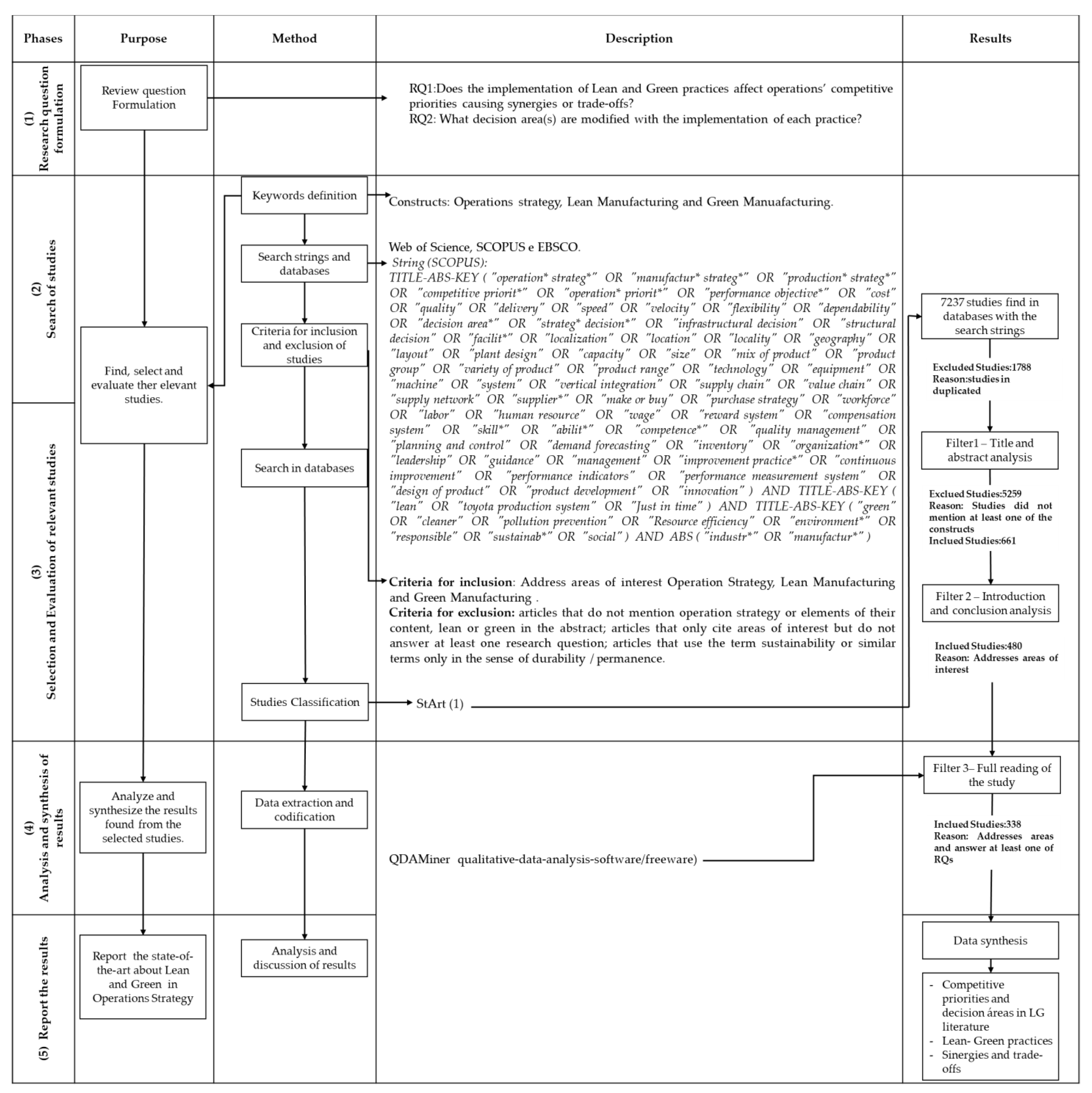
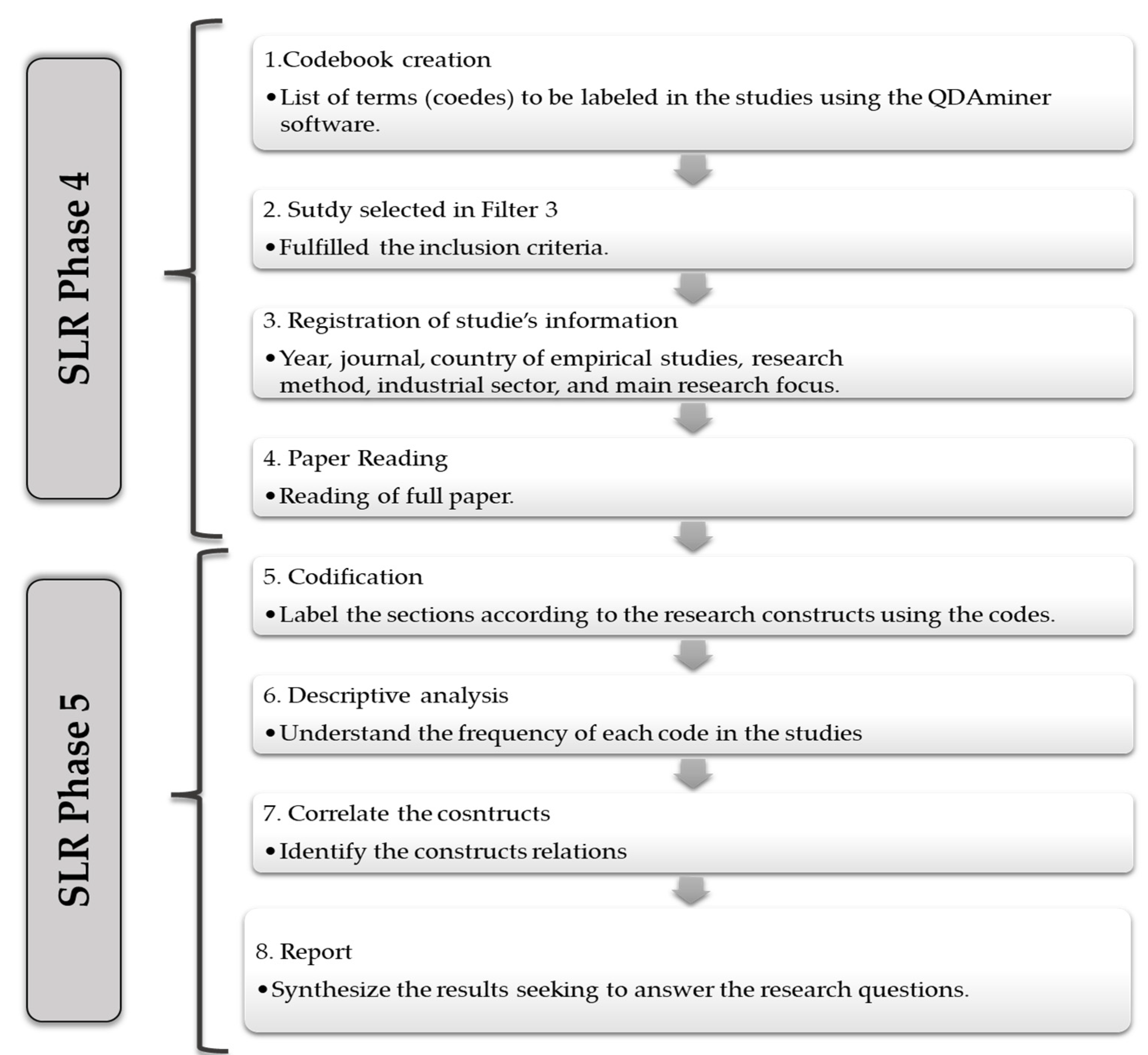
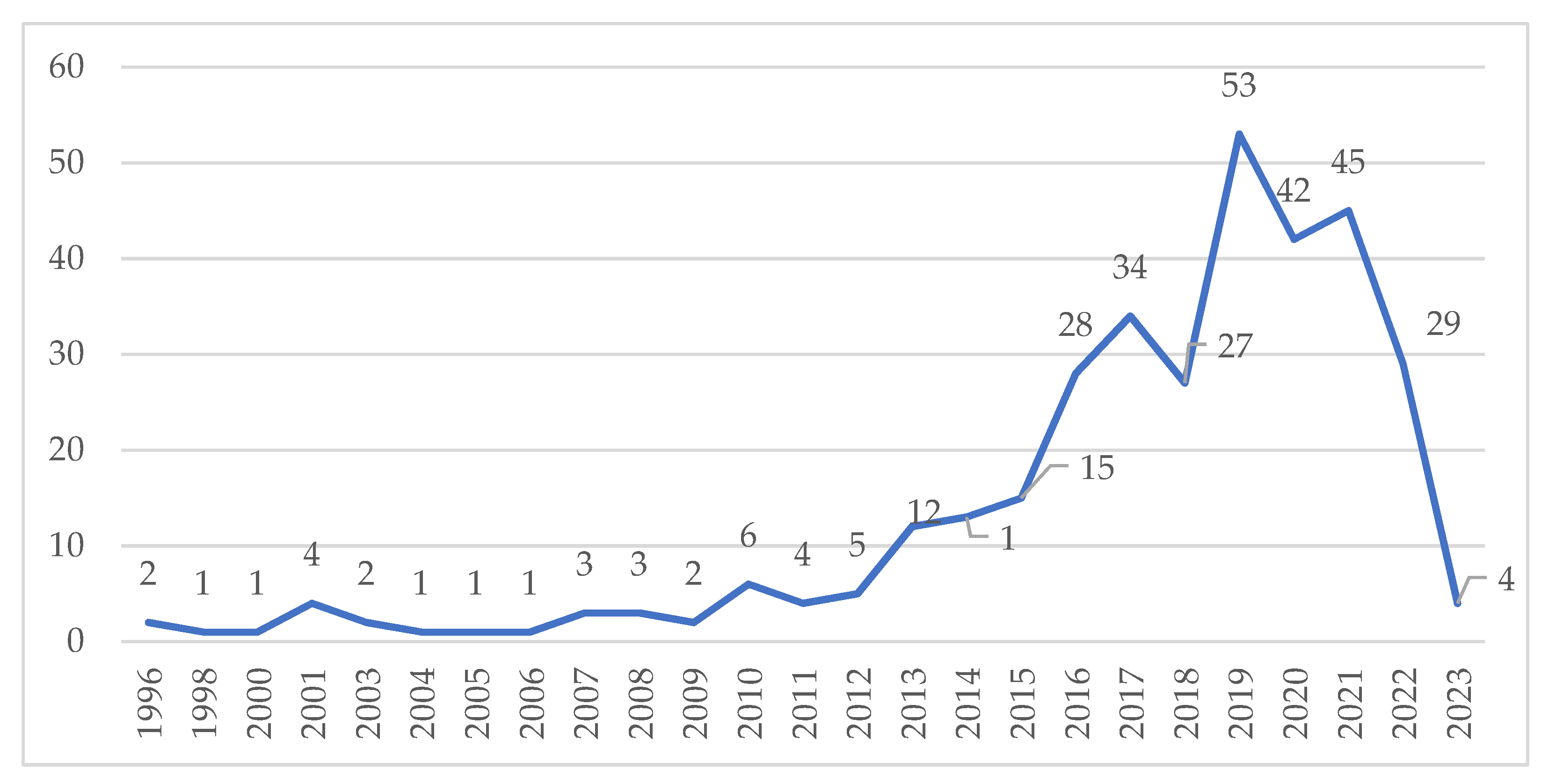
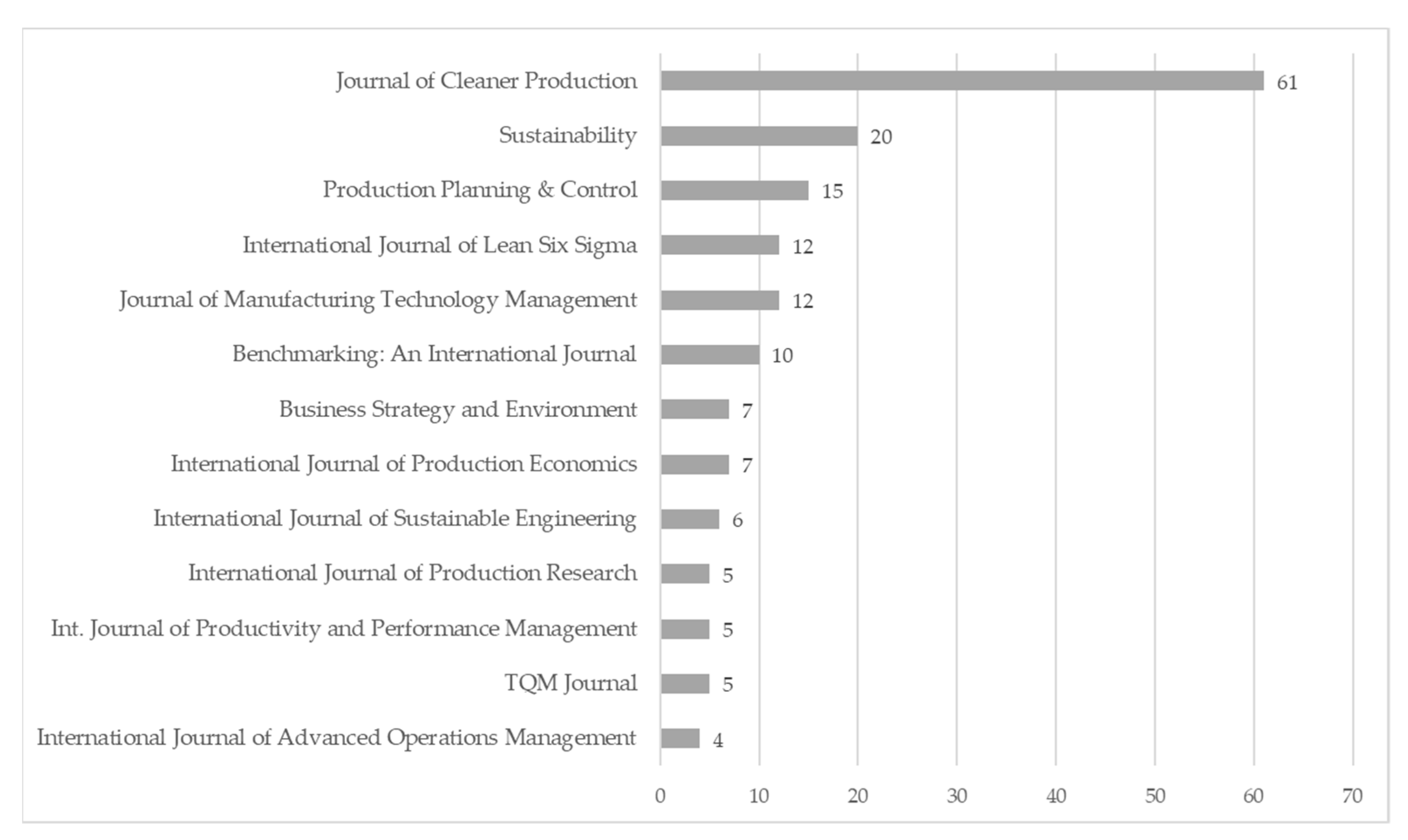
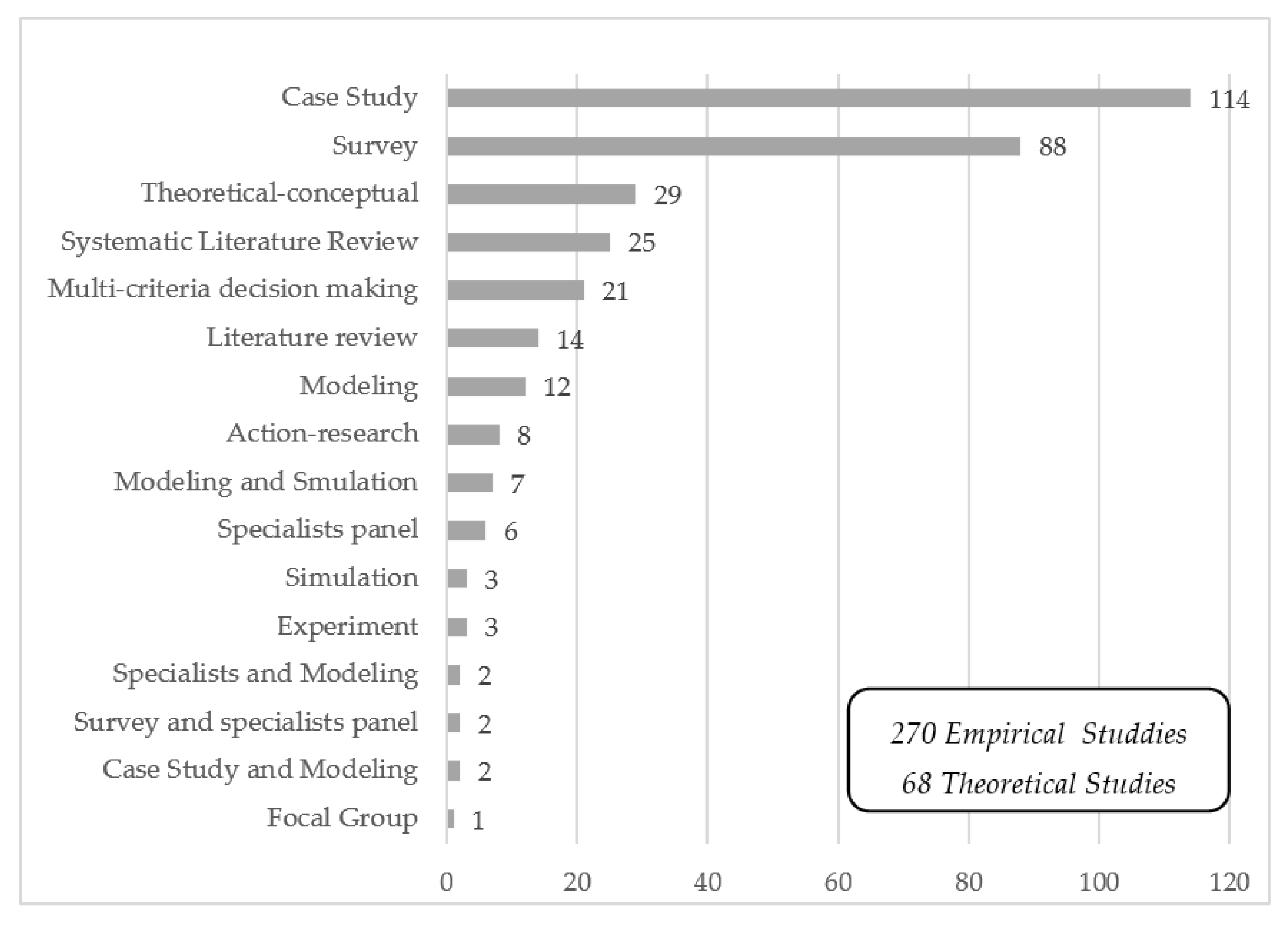
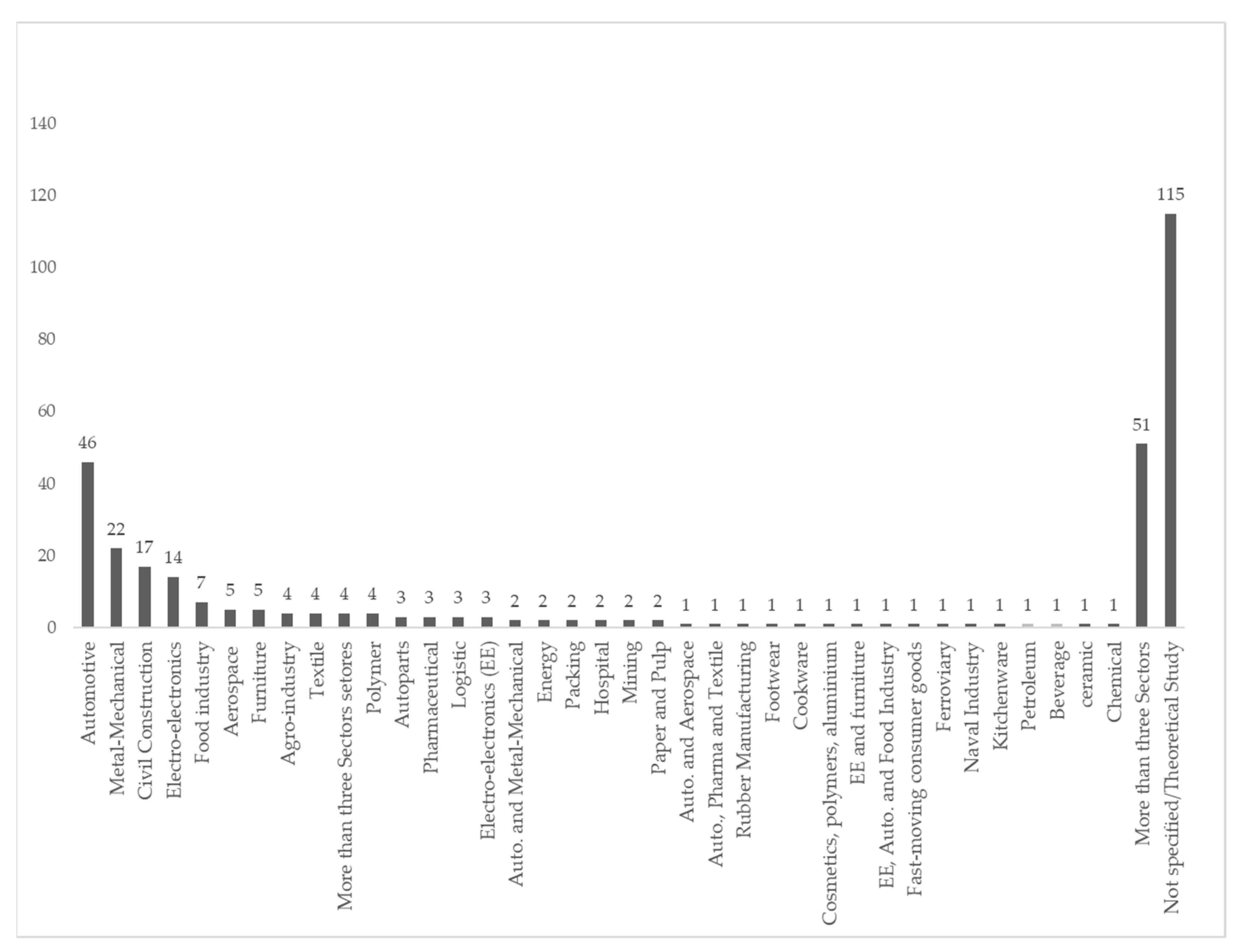
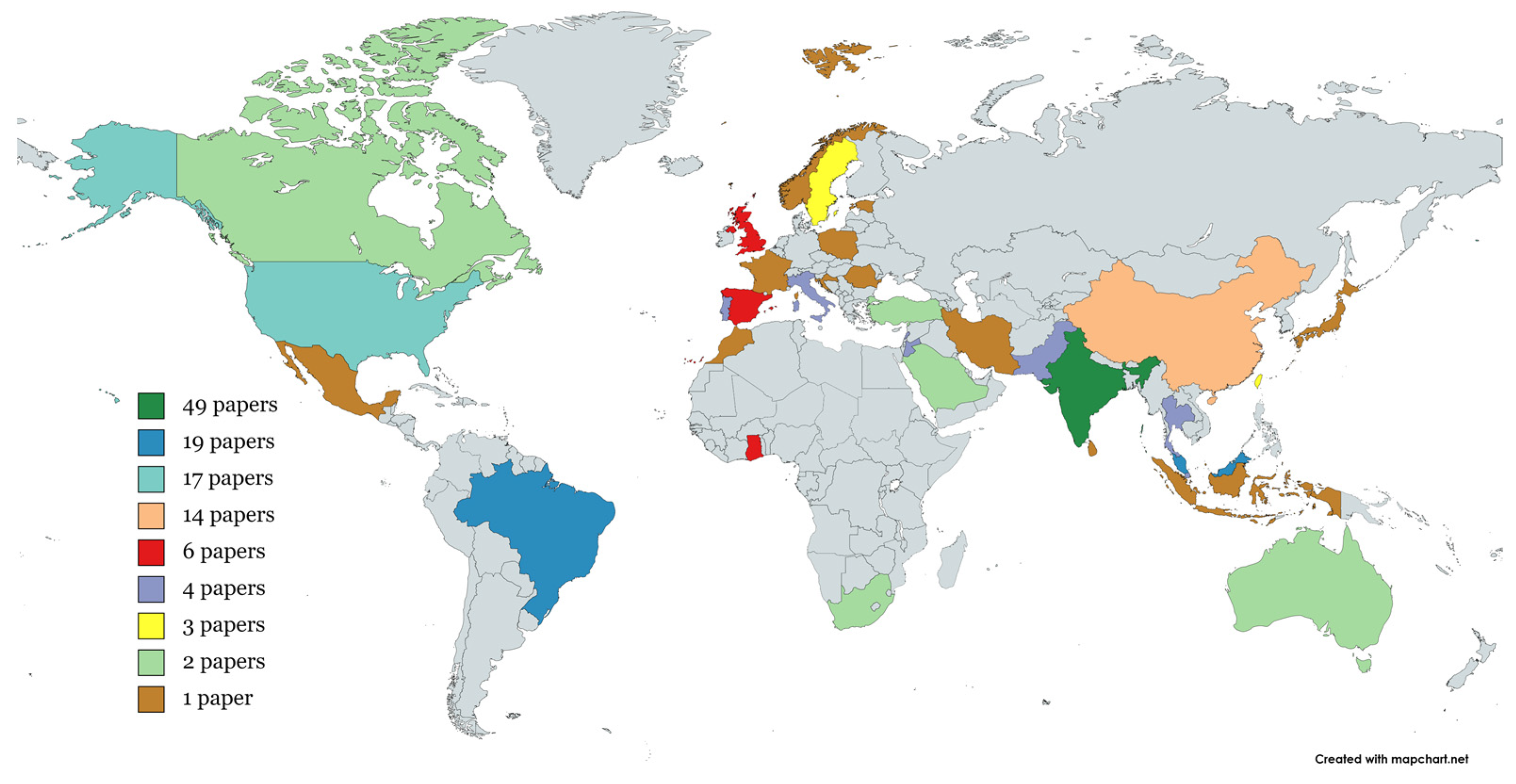

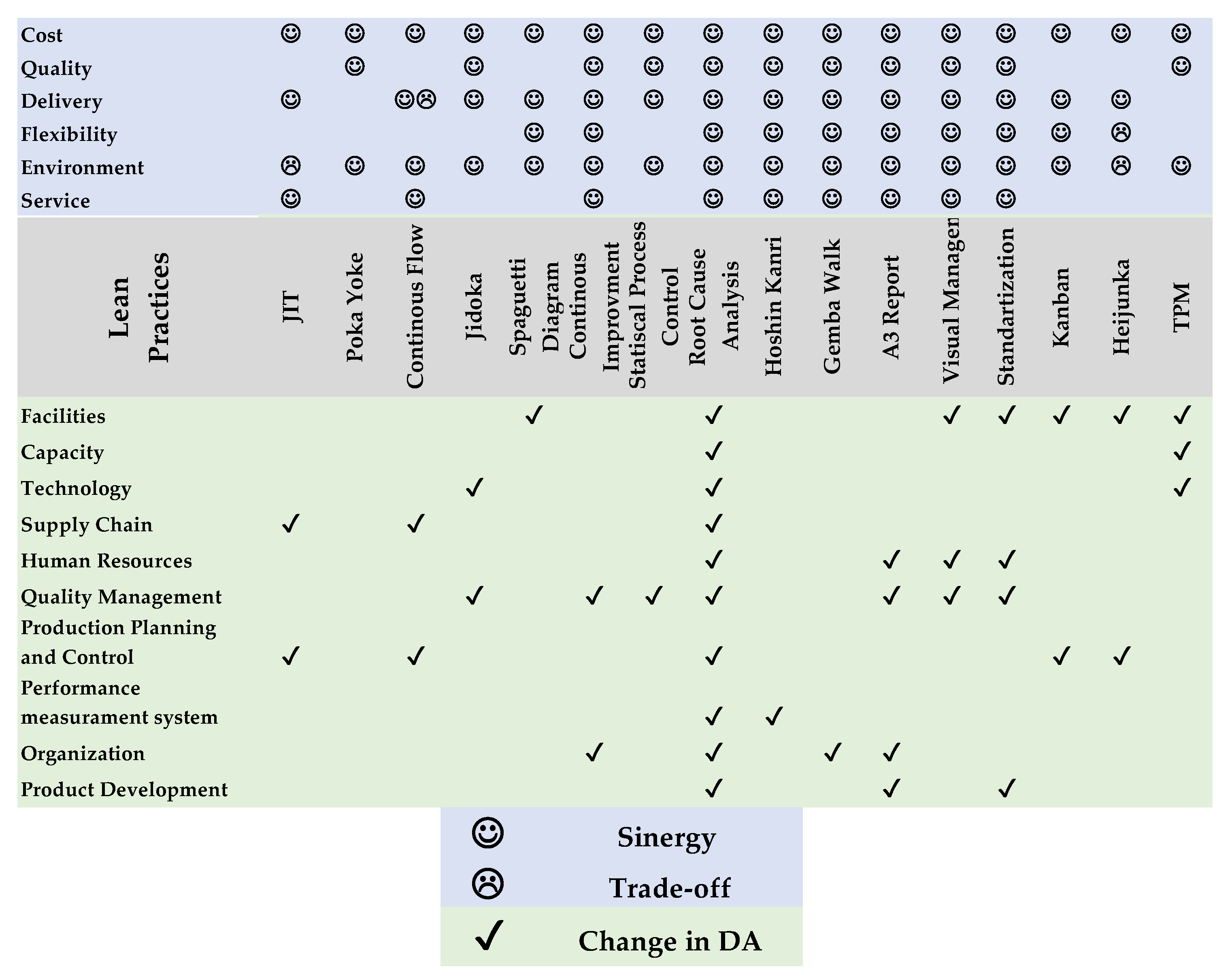
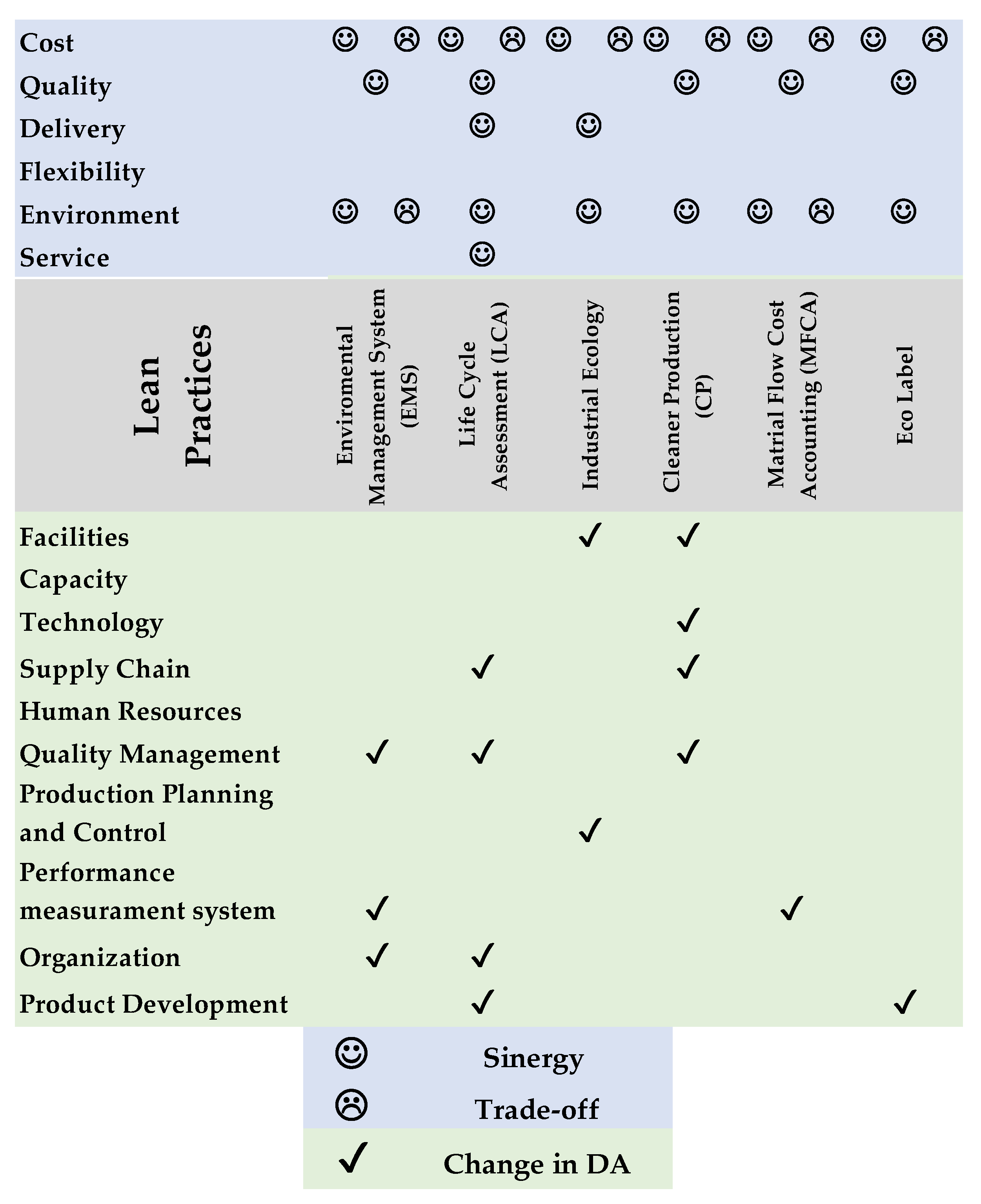
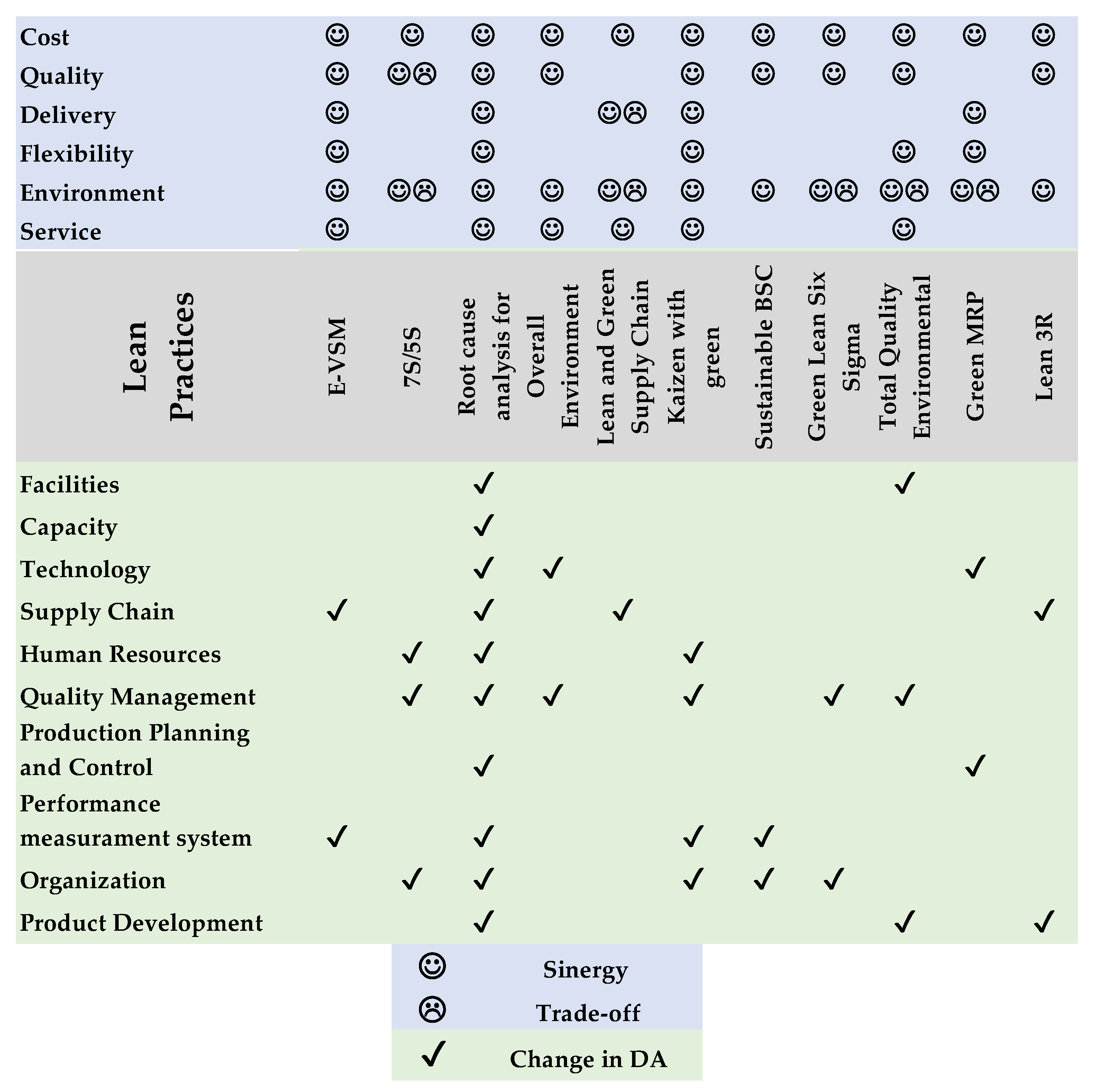
| Country of Study | Total of Studies | Total of Studies (%) |
|---|---|---|
| Not specified or theoretical study | 136 | 40.24% |
| India | 49 | 14.50% |
| Brazil | 19 | 5.62% |
| Malaysia | 19 | 5.62% |
| United States | 17 | 5.03% |
| China | 14 | 4.14% |
| Several countries | 9 | 2.66% |
| United Kingdom | 6 | 1.78% |
| Spain | 6 | 1.78% |
| Ghana | 6 | 1.78% |
| Portugal | 4 | 1.18% |
| Singapore | 4 | 1.18% |
| Jordan | 4 | 1.18% |
| Pakistan | 4 | 1.18% |
| Thailand | 4 | 1.18% |
| Italy | 4 | 1.18% |
| Sweden | 3 | 0.89% |
| Taiwan | 3 | 0.89% |
| Australia | 2 | 0.59% |
| Canada | 2 | 0.59% |
| Various | 2 | 0.59% |
| South Africa | 2 | 0.59% |
| Saudi Arabia | 2 | 0.59% |
| Turkey | 2 | 0.59% |
| North Africa | 1 | 0.30% |
| France | 1 | 0.30% |
| Estonia | 1 | 0.30% |
| Poland | 1 | 0.30% |
| Romania | 1 | 0.30% |
| Faroe Islands | 1 | 0.30% |
| Norway | 1 | 0.30% |
| Japan | 1 | 0.30% |
| Croatia | 1 | 0.30% |
| Wales | 1 | 0.30% |
| Sri Lanka | 1 | 0.30% |
| Indonesia | 1 | 0.30% |
| Mexico | 1 | 0.30% |
| Iran | 1 | 0.30% |
| Morocco | 1 | 0.30% |
Disclaimer/Publisher’s Note: The statements, opinions and data contained in all publications are solely those of the individual author(s) and contributor(s) and not of MDPI and/or the editor(s). MDPI and/or the editor(s) disclaim responsibility for any injury to people or property resulting from any ideas, methods, instructions or products referred to in the content. |
© 2023 by the authors. Licensee MDPI, Basel, Switzerland. This article is an open access article distributed under the terms and conditions of the Creative Commons Attribution (CC BY) license (https://creativecommons.org/licenses/by/4.0/).
Share and Cite
Queiroz, G.A.; Delai, I.; Alves Filho, A.G.; Santa-Eulalia, L.A.d.; Torkomian, A.L.V. Synergies and Trade-Offs between Lean-Green Practices from the Perspective of Operations Strategy: A Systematic Literature Review. Sustainability 2023, 15, 5296. https://doi.org/10.3390/su15065296
Queiroz GA, Delai I, Alves Filho AG, Santa-Eulalia LAd, Torkomian ALV. Synergies and Trade-Offs between Lean-Green Practices from the Perspective of Operations Strategy: A Systematic Literature Review. Sustainability. 2023; 15(6):5296. https://doi.org/10.3390/su15065296
Chicago/Turabian StyleQueiroz, Geandra Alves, Ivete Delai, Alceu Gomes Alves Filho, Luis Antonio de Santa-Eulalia, and Ana Lúcia Vitale Torkomian. 2023. "Synergies and Trade-Offs between Lean-Green Practices from the Perspective of Operations Strategy: A Systematic Literature Review" Sustainability 15, no. 6: 5296. https://doi.org/10.3390/su15065296
APA StyleQueiroz, G. A., Delai, I., Alves Filho, A. G., Santa-Eulalia, L. A. d., & Torkomian, A. L. V. (2023). Synergies and Trade-Offs between Lean-Green Practices from the Perspective of Operations Strategy: A Systematic Literature Review. Sustainability, 15(6), 5296. https://doi.org/10.3390/su15065296







